Multiples adventures
Dominicans and Franciscans in Maya land - XVIth century
A trip by Las Casas to Tabasco and Chiapas
Pedro de Barrientos in Chiapa de Corzo
Las Casas against the conquistadores
Fuensalida and Orbita, explorers
Numerous studies
An ethnologist friar, Diego de Landa
Two teachers, Juan de Herrera and Juan de Coronel
Two historian friars, Cogolludo and Remesal
A multitude of buildings
A Franciscan turned architect: Friar Juan de Mérida
The Valladolid convent in the Yucatán
The Izamal convent and its miracles
In the Yucatán, a church in every village
A Dominican nurse, Matías de Paz
A difficult task: evangelization
The creation of the monastery of San Cristóbal
The Dominican province of Saint-Vincent
An authoritarian evangelization
Franciscans and the Maya religion
The failure of the Franciscans in Sacalum, the Yucatán
Domingo de Vico, Dominican martyr
The end of the adventure
Additional information
The Historia Eclesiástica Indiana of Mendieta
The road of Dominican evangelization in Guatemala
The convent of Ticul, as seen by John Lloyd Stephens
The Franciscans in the Colca valley in Peru
The convent route of the Yucatán in the XVIth century
The dominican mission of Copanaguastla, Chiapas
Available upon request: -
general information upon Maya countries, - numbered texts
on the conquest and colonization
of Maya countries
Address all correspondence to:
moines.mayas@free.fr
|
THE CONVENT ROUTE OF THE YUCATÁN IN THE XVIth CENTURY
|

A Franciscan on the road, former bus terminal, Toluca
Fray Alonso Ponce arrived in Mexico in 1584 as Commissary General, Visitor of the Franciscan Provinces of New Spain.
He spent the next five years traveling through every country of New Spain and more, exploring all the area from as far north as present-day Nayarit to as far south as Nicaragua. In this time, he visited 166 Franciscan monasteries in the colony, as well as eight monasteries run by Dominicans, five by Augustinians and three by Jesuits. He covered a distance of 2,557 leagues (6,000 miles), walking.
He was accompanied in his travels by a secretary and a Mexican-speaking interpreter. His secretary, Antonio de Ciudad Real, a Franciscan, was sent in 1572 as a chorister to the Yucatan to accompany Diego de Landa. He rapidly became fluent in spoken Maya. By 1584, Ciudad Real was back in Texcoco, near Mexico City, and when Ponce arrived, he appointed him as his secretary for his inspection tour of the missions throughout New Spain.
Antonio de Ciudad Real traveled everywhere with him, and left us a detailed account of their trips, bearing the title "Tratado curioso y docto de las grandezas de la Nueva Espana: Relacion breve y verdadera de algunas cosas de las muchas que sucedieron al padre fray Alonso Ponce en las provincias de la Nueva España, siendo comisario general de aquellas partes. (Curious and learned treatise on the splendors of New Spain: Brief and true account of some of the many things that happened to Father Alonso Ponce in the provinces of New Spain, when he was General Commissary of those parts)".
Antonio de Ciudad Real describes their course through the present-day "convent route", in the Yucatán peninsula:
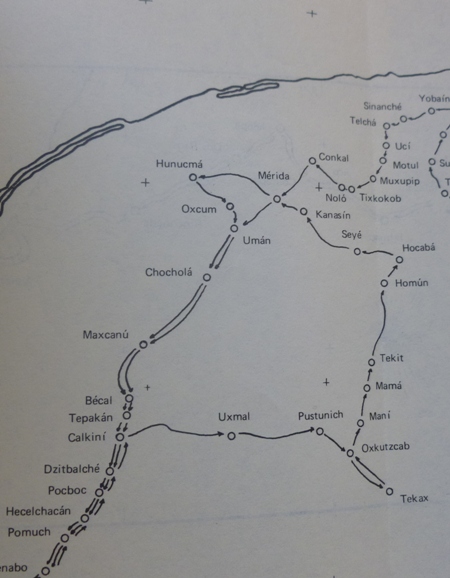
Fray Alonso Ponce's route, from Uxmal to Mérida
Fray Alonso Ponce visits the Maya ruins of Uxmal
"On Tuesday, the thirteenth of October [1588], the Father Commissary left Calkini at two o’clock in the morning, and leaving the road which leads to Merida, he took the road for Mani and Oxkutzcab, and traveling six leagues of good road, arrived early at some ranchos or houses of thatch, which the Indians of the district of Mani with their keeper had made near some ancient edifices, very renowned in that land, which they called Uxmal. There they gave him a good reception and lodging and all kindness and comforts, and there he remained all that day and saw some of the buildings mentioned, about which, because of their being remarkable, something will be said in this place."
"On the north of the ranchos where the Father Commissary was lodged, as has been seen, which is about twenty leagues from Merida, to the south of that city, stands a ku or mul, very tall and made by hand. It is very difficult to ascend this by its one hundred and fifty stone steps, which are very steep and which, from their being very old, are very dilapidated. On the top of this mul a large building has been built, consisting of two vaulted rooms, made of stone and lime, the stones being carved with great care on the outside. In old times they took the Indians who were to be sacrificed to these rooms, and there they killed them and offered them to the idols. The Father Commissary went up this mul as soon as he arrived there, and this surprised the others greatly, since many others did not dare to go up and could not have done so if they had tried." [...]
(Antonio de Ciudad Real, Tratado curioso y docto de las grandezas de la Nueva España, Book II, Chap CLI)

Fray Alonso Ponce went up the Pyramid of the Magician in Uxmal (2024, March, King and Queen of Sweden visit the archaeological site)
"The Indians do not know surely who built these buildings nor when they were built, though some of them did their best in trying to explain the matter, but in doing so showed foolish fancies and dreams, and nothing fitted into the facts or was satisfactory. The truth is that today the place is called Uxmal, and an intelligent old Indian declared to the Father Commissary that, according to what the ancients had said, it was known that it was more than nine hundred years since the buildings were built. Very beautiful and strong they must have been in their time, and it is well known from this that many people worked to build them, as it is clear that the buildings were occupied, and that all about them was a great population, since this is now evident from the ruins and remains of many other buildings, which are seen from afar; but the Father Commissary did not go to these ruins, since the thicket was very close and dense, and there was no opportunity to open and clear out a path so as to reach them. And now they all serve only as dwellings and nests for bats and swallows and other birds, whose droppings fill the rooms with an odour more disgusting than delightful. There is no well there, and the farmers of the vecinity carry their drinking water from some little pools of rain-water which there are in that region. It may be easily suspected that these buildings were depopulated for want of water, although others say that this is not so, but that the inhabitants departed for another country, leaving the wells which were there choked up."
(Antonio de Ciudad Real, Tratado curioso y docto de las grandezas de la Nueva España, Book II, Chap CLII)
He passes through the town of Muná
"Two and half leagues from here [Uxmal] is a handsome town of the guardianía of Maní, called Muna, where they gather the famous honey that the Spaniards, corrupting the word, call “honey of Mona”. The Indians of that town came to receive the Father Commissary with those of Maní because Muna lies in its jurisdiction and its milpas reach near the same buildings on the north and on the west as do the milpas of Calkini –all this is good land for them."
(Antonio de Ciudad Real, Tratado curioso y docto de las grandezas de la Nueva España, Book II, Chap CLII)

Through the town of Muná
Fray Alonso Ponce inspects the convent of Oxkutzcab
"Thursday, September 15th, he left that town [Puztunich] at dawn and travelling two long leagues of a level road through savannahs and pastures, at the foot of the same range of hills [the Puuc Sierra], arrived early to say mass at the town itself and convent of Oxkutzcab, where he was very well-received and they made him a great fiesta. That town is large, of the same Maya Indians as the others of the guardianía, a people all very pious; it is built in a plain, at the foot of the aforementioned sierra and there are two anorias, with which they draw water for the sustenance of the whole town: the Indians came with presents of turkeys, iguanas, eggs, melons and honey. The convent (dedicated to our Father San Francisco) is a small house, without cloister, new and strong, of stone and mortar, very fine and neat, with four upper cells and a room in which is the Most Holy Sacrament; for the Indians there is in the patio, which is surrounded by orange-trees, a good ramada, with its chapel, choir and sacristy, as in the rest of the convents. The garden is small and recently-planted, it had orange, alligator-pear, guava, banana-trees, and zulumuyes, all of which, with the garden stuff, is watered with water from one of the two anorias of the town. Two monks were living there; the Father Commissary visited them and remained with them that day and the following."
(Antonio de Ciudad Real, Tratado curioso y docto de las grandezas de la Nueva España, Book II, Chap CLIII)
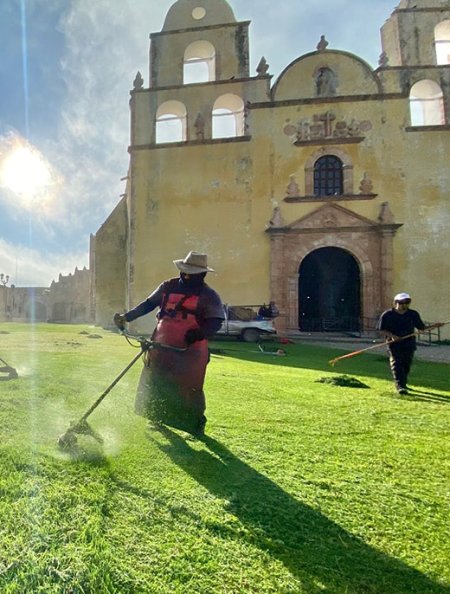
Oxkutzcab, 2023, December 19, cleaning the atrio of the convent of Saint Francis of Assisi
Fray Alonso Ponce stays five days in Tekax
"Saturday, September 17th, he left Oxkutzcab, a little before it was day, and travelling three leagues of level road, a little away from the foot of the aforementioned sierra, he arrived early to say mass at the town and convent of San Juan Bautista of Tikax [Tekax]. The cacique came out almost a league to receive him with the principal Indians and many others, on foot and on horseback, and with them a multitude of boys, who did honor to the Father Commissary as far as the convent, giving shouts and hurrahs, throwing oranges at each other and receiving the blows on shields made of sticks which they carried. Also two groups of dancers in the manner of the Spaniards came out, and another of boys dressed as little black people, representing devils, who in verses sung them in canto de organo. Hearing the name of Jesus, all fell to the ground and trembled, making a thousand grimaces and writhing as a sign of fear and consternation. At the gate of the patio was the main body of people, numberless men and women, all in procession with many crosses and andas and much music of flutes and trumpets; and finally, he was received with great merrymaking, ceremony and devotion. The Indians came with presents of turkeys, honey, melons, alligator-pears, zulumuyes, the principal ones as well as others and they did this not only that day but on all the others he was there. That town has a great population of Maya Indians, and of the same are the others of the guardianía; it lies on a plain at the foot of the mentioned sierra and there are in it many fruit-trees of the Indies and the hot country; it has two anorias with which water is drawn for the sustenance of all. The convent is a small house of stone and mortar, without cloister, with as many cells and a room for the Most Holy Sacrament as that in Oxkutzcab. The Indians have their ramada, all within the patio which is surrounded with orange-trees and has four chapels, one in each corner. The garden of the convent is good and large, and there are in it many orange, guava, alligator-pear, zapote and banana-trees, zulumuyes, pitahayas and a very beautiful coconut-tree; all is irrigated with water that comes from one of the two anorias of the town. Two monks were living there; the Father Commissary visited them and remained with them five days, as much on account of affairs that presented themselves as because he was indisposed."
(Antonio de Ciudad Real, Tratado curioso y docto de las grandezas de la Nueva España, Book II, Chap CLIII)

In front of the convent of Tekax (2023, December 22, Policeman Day)
Antonio de Ciudad Real explores a cave, near to Tekax
"At about three quarter of a league from the village of Tikax, between East and South, there is a visible and remarkable cave which, were it located in Spain, would have more importance than it has here, since it would be the perfect spot for a hermit or a monk wishing to live a solitary life of contemplation. If the place were needed for recreation, it would equally be appropriate. This cave is beyond the sierra which crosses it, from Tikax to the mouth of the cave. It contains two tunnels, one bigger than the other, with many vaults, some very high and more apparent than others […] There are others in which the water coming from high altitudes becomes distillated, and the resulting calcium forms various shapes and silver moldings looking like vestments and clothes hanging from their collar and appearing like prominent wrinkles. Apart from this water depositing calcium, there are a lot of clusters hanging, and some of them have even reached the floor, and it is possible to walk between one cluster and the other, and if a stone is projected against them, the resulting noise is that of marble being hit. There are many of these pillars which somehow remind one of the old church in Córdoba, which was a long time ago a mosque for the Moors, so numerous they are."
(Antonio de Ciudad Real, Tratado curioso y docto de las grandezas de la Nueva España, Book II, Chap CLIII)

The convent of Maní (2022)
About the stay of Alonso Ponce and Antonio de Ciudad Real in Maní, look at the page "A Franciscan turned architect, Fray Juan de Mérida"
A Franciscan turned architect, Fray Juan de Mérida
Fray Alonso Ponce in Mayapán
"In that guardianía, near a mission-town called Telchac, a very populous city once existed called Mayapan. […] Now on its site are seen many foundations and walls of stone and mortar houses, many mounds (mules) and temples of the idols, and especially a very tall one, which one mounts by four stone stairways, with small but very wide steps, placed at the four points of the compass, one at each. On the top of this mound is a house of stone and mortar, vaulted, with certain small rooms, which the priests of the idols, they say, entered to pray. Near the foot of this same mound there is a very deep zonote with a very smooth stone on the edge of its mouth, from which (it is said) they used to throw those whom they sacrificed to their gods. It can easily be seen that there was a great population there in times gone by."
(Antonio de Ciudad Real, Tratado curioso y docto de las grandezas de la Nueva España, Book II, Chap CLIV)

Tourists in the ruins of Mayapán
Through the Convent Route, by Mamá, Tekit and Homún
"Monday, September 26th, the Father Commissary left Mani at dawn and travelling two leagues on a somewhat rocky road arrived before day at a fair-sized town of the same guardianía called Mama. The Indians received him with many armadas, lights and music of flutes and some dances; he thanked them and passed on, and travelling another league on the same road, arrived at another town of the same guardianía called Tikit [Tekit] when it was already day, where they gave him a similar reception, with a great crowd of Indian men and women; next to the church of this town there is a very deep pit and below a sort of cave or grotto of water, from which the whole town drinks; the Indian women had been accustomed to descend with the greatest trouble and danger to draw it, and the guardian of Mani made three stone steps that lead below by which they now descend with ease and with no danger whatever.

Patronal feast at Tekit, in front of the convent, 2023, May
"The Father Commissary proceeded in order to arrive in time to eat at the convent of Humun, which is five leagues from there, and travelling two and a half very rocky leagues, arrived when it was already afternoon at a water-hole or zonote called Ochil, where in older times was an Indian town: there the cacique of Humun was and many others of that town and in a ramada that they had made hastily, they had breakfast ready for the Father Commissary, which served him also as noon-dinner.
"He remained there about an hour, and continuing his journey, after travelling another two and a half leagues of a somewhat better road, arrived very tired and weary at the town aforementioned and convent of Humun (Homun), where they received him well with many people and a few dances, and some masked men who, dancing and making very sightly gestures and mummeries, also imitated, very naturally, the song of certain nocturnal birds of that country: there was music of flutes and trumpets, and many Indians came out on horseback. That town is of medium size, of Maya Indians, of which the rest of the guardianía also are; from all the towns came the principal people with presents of turkeys and bunches of bananas. There is in Humun an anoria with which they draw water for the whole town, and there are in its vicinity, several zonotes in which many fish live."
"The convent, dedicated to San Buenaventura, had the lower cloister and four upper cells and another one in which is the Most Holy Sacrament, all made of stone and mortar; it has a little garden with a few orange-trees and chicozapotes, and in it a well from which they draw water by hand: for the Indians there is their ramada and chapel as in the rest of the towns. Two monks were living there; The Father Commissary visited them and remained with them that day and the following."
(Antonio de Ciudad Real, Tratado curioso y docto de las grandezas de la Nueva España, Book II, Chap CLIV)

The convent of Homún (2024, July)
A fifty six kilometers long trip, from Hocabá to Mérida
"Wednesday, September 28th, the Father Commissary left Humun in daylight and traveling two leagues of good road, arrived early to say mass at the convent and town of San Francisco of Hocaba, where he was very well-received with armadas and dances. Many Indians came out on foot and on horseback with certain devices, and next to the church there was a great concourse of people, many crosses and andas, with music of flutes and trumpets. The town is small, of Maya Indians and of the same are the other [towns] of the guardianía. In it there is an anoria and stone trough from which they draw water for the sustenance of all the townspeople, and of this a little enter the convent for watering a little garden and for the service of the house. The convent is a single building with four upper cells and refectory and oficinas below, all built of stone and mortar. It was likewise a lower room in which is kept the Most Holy Sacrament, next to which is the chapel and ramada of the Indians. Two monks were living there; the Father Commissary visited them and remained with them that day and the following."

Hocabá church
"Friday, September 30th, the Father Commissary left Hocaba so early in the morning that it was hardly midnight, and travelling three leagues of a level cart-road, arrived at a small town of that guardianía called Ciye [Seye]. The Indians received him at that hour with many lights and dances. He thanked them and continued his journey, and travelling five more leagues on the same road, arrived in the dawn just before sunrise at another small town called Tecanantzil, of the guardianía of Mérida, where he was also well-received. And having rested about a half-hour in the church, he pursued his task and travelling another league on the same road, arrived to say mass at the convent of Mérida very early in the morning and took the friars so completely unawares, that until he was inside he was not heard, because never had they believed nor even imagined that with a day’s trip of nine leagues he could arrive so early; and what surprised them more was to see him say mass after such a long morning and after so many leagues on the road.
"The Father Commissary preached there in our convent on the day of our Father San Francisco; the Bishop, the Governor and the whole city heard him and everybody was very happy with his sermon and teaching and the feast was held with much solemnity and spiritual rejoicing. Afterwards he visited the convent, the only one left for him to inspect, and in his inspection and other matters relative to the province, the Father Commissary remained till the 15th of October, which was the day on which the election of the provincial and the definidores was to be held."
(Antonio de Ciudad Real, Tratado curioso y docto de las grandezas de la Nueva España, Book II, Chap CLV, Translated by Ernest Noyes, in Fray Alonso Ponce in Yucatán 1588, The Tulane University of Louisiana, New Orleans, 1932)

Merida, Lucas de Gálvez market, built on the place of the Franciscan convent
Antonio de Ciudad Real in Merida
"It lies ten leagues from the sea and from a port called Çizal (Sisal), where they unload the merchandise that comes from Spain and much of that which is brought from Mexico, and they carry it from there in carts and on pack-animals to Mérida, called in the language of the Indians Tiho because it is founded on the site of an old city of that name. […]
"In the neighborhood of that city there are many savannahs and much pasture-land and there are many ranches of cattle and sheep because there is pasturage for all kinds; and for watering them they have wells dug and very large troughs, and they draw the water with anorias.
"Our convent is close to the same city, set on an ancient ku or mul, and a part of it is even built on the old buildings themselves of the ancient Indians. It is all constructed of stone and mortar with its upper and lower cloister, dormitories and cells. There is a large garden in it where many oranges, limes and lemons, bananas, alligator-pears, zapotes and chico zapotes, zulumuyes, pitahayas, guavas, dates and mameys of Santo Domingo grow. There are also some cassia-trees, which although they bear a flower which makes a certain preserve that serves as a mild purge, the stalk never has been boiled (cuajado). All these and the garden stuff are irrigated with water drawn by an anoria.
"That convent has a vaulted church with a main arch and great chapel, built of bonded stones, and in this chapel are hung and preserved the flags that the Spaniards brought into the province when they conquered it.
"In the same chapel are buried almost all the friars who have died in that province because that convent is the most important and the head one of all the others, and where the chapters, meetings and assemblies are usually held, and as it is the infirmary of the whole province, all go there for treatment, and thus, most of them who die, die in that house. Among the many buried there are three most distinguished and famous for having been great servants of God, of great exemplary lives and of each of them there will here be said a few words for the glory and honor of God and the edification of those who might read them; and first the holy Bishop, Don Fray Diego de Landa, will be discussed."
(Antonio de Ciudad Real, Concerning the city and convent of Mérida in Yucatan, and some friars who are buried there.)

Merida, May 8, 2022, feminists vandalized the monument to Los Montejos, conquerors of Yucatan, as a protest for legal abortion and femicide status
Antonio de Alcedo, 1786:
"Merida, another city, the capital of the province and government of Yucatán in N. America, and kingdom of Nueva España; founded by Captain Francisco de Montejo in 1542. It is well situate, and has beautiful buildings, and streets wide and running straight from e. to w. and divided by others which intersect them and form certain equal squares; the chief square is also handsome and very large, and is entered by eight streets, the front of which, is that looking to the e. and in which is the cathedral church, one of the handsomest of any in Nueva España; another, which look n. containing the governor’s house, and another looking s. composed of houses which were built with much magnificence by the founder. The territory is level, that the streams can scarcely run down the streets, and on this account there are many wells for holding the water.
"It is the head of a bishopric, created in 1518, has too curacies for the administration of the sacraments, one for the Spaniards, another for the Indians, being also used by five settlements or wards of the city, called Santiago, Santa Ana, Santa Lucia, Santa Catalina, and San Sebastian; two convents of the religious order of San Francisco, one called the Grande, and is magnificent, the other the church of Nuestra Señora de la Mejorada, built in imitation of that of Doña Maria de Aragon in the court of Madrid, and close to this the parish church of San Cristoval for the Indians, an hospital of San Juan de Dios, a college which belonged to the abolished order of Jesuits, and a monastery of nuns. Its population is composed of only 400 housekeepers, having much diminished through an epidemic disorder experienced in 1548; but the number of Mustees, Mulattoes, and Negroes, is very great. It is 28 miles from the sea-coast, in Lat. 20° 50’ n. Long. 89°30’ w."
(Antonio de Alcedo, Diccionario geografico-histórico de las Indias Occidentales o América: es a saber: de los Reynos del Peru, Nueva España, Tierra Firme, Chile y Nuevo Reyno de Granada. Madrid, 1786/89)

Mérida, San Cristóbal, former church of the Indians, Guadalupe Day
The San Cristóbal barrio was originally an area set aside by Montejo in the 1540’s to house the Indians from Central Mexico who moved to Yucatan to help
him conquer the Mayans. The San Cristóbal Church was the last one built by Spaniards in the Yucatan. The foundation stone was laid in 1757 and the church was dedicated to the Virgin of Guadalupe the following year to mark the Pope’s official recognition of Mexico’s popular patron saint. The church took forty years to build. It was finally completed in December of 1796, and the architect is supposed to be Juan de Torres, who was also the builder of the main church in Uman. San Cristóbal recalls the main Cathedral in the Plaza Grande with its multi-level twin towers and lofty facade. It shares the recessed shell archway with the church in Uman, and has a choir window featuring the Virgin.
2025 "Friars and Mayas"
|

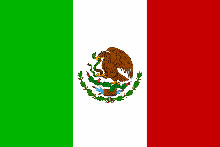

Antonio de Ciudad Real, "Tratado curioso y docto de las grandezas de la Nueva España. Relación breve y verdadera de algunas cosas de las muchas que sucedieron al padre fray Alonso Ponce en las provincias de la Nueva España siendo comisario general de aquellas partes", México, Universidad Nacional Autónoma de México, 1976

Uxmal, october, 2022, a Maya stela has been uncovered in the archeological site. The discovery was part of a project to recover artifacts that could fall in the path of the "Mayan Train" (2023, February, the stela exhibited in Mérida)
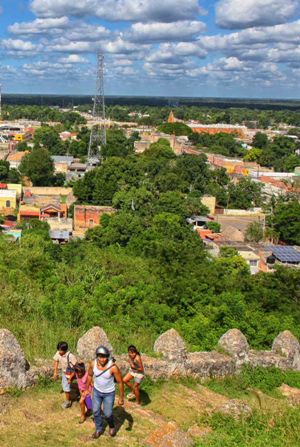
The town of Tekax, as seen from the chapel of San Diego, built in the Puuc hills
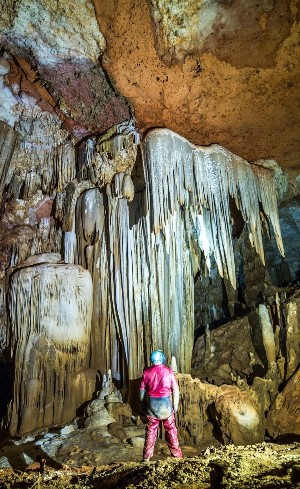
The Chocantes cave, one of the twenty caves known in Tekax area

Tekax, 2024, May, peaces of one of the arches of the church San Juan Bautista collapsed without people affected
The life of Fray Alonso Ponce (1527 (?) – 1592)
Father Alonso Ponce de León, guardián of the convent of Nuestra Señora del Castañar, and confessor of the Province of Castile, was appointed Commissary General of the Franciscan Order in New Spain in 1584. He landed for the first time on the mainland at San Juan de Ulúa, near the present Veracruz, on September 12, of that year. He was 57 years old.
1584-1588: Ponce and his secretary Ciudad Real realized a remarkable tour of inspection of convents not only in Mexico but in those parts we now call Guatemala, Salvador and Nicaragua.
Ponce was not well-received in Mexico. He found the viceroy antagonistic and his authority questioned by the Franciscans of the province of Mexico (Franciscan province of the Holy Gospel), managed by the provincial of Mexico, Fray Pedro de San Sebastián, and his definidor, Fray Bernardino de Sahagún. Ponce excommunicated them.
February 1588: Alonso Ponce and Ciudad Real were arrested and deported from New Spain, by order of the viceroy, marquis Alvaro Manrique de Zúñiga. For they left the fleet in Havana and came back to Yucatan.
July-September 1588: Ponce inspected the convents of the Yucatan. While he was still awaiting in Mérida, they informed him that his successor, Fray Bernardino de San Cebrian, who had arrived in the fleet in September, requested his presence in conference at Jalapa.
Leaving Mérida January 25, 1589, Ponce and Ciudad Real returned to Campeche and embarked for San Juan de Ulúa February 6, and then for Spain June 13 of that year.
In Spain, Fray Alonso Ponce was elected guardián of the convent of Alcalá de Henares, and then became a confessor of the Duke of Infantado. He died at Guadalajara (Castilla-La Mancha), in 1592. He was 65 years old.